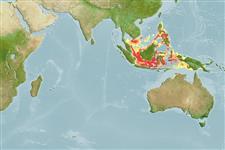Teleostei (teleosts) >
Ovalentaria/misc (Various families in series Ovalentaria) >
Pseudochromidae (Dottybacks) > Pseudochrominae
Etymology: Pictichromis: Name from Latin pictus meaning painted or colored, and Greek Chromis, a genus of pomacentrid, used as the stem for other fish genera; alludes to the bright live colorations of the included species (Ref. 81967); caitlinae: Named for Ms. Caitlin Elizabeth Samuel..
More on authors: Allen, Gill & Erdmann.
Environment: milieu / climate zone / depth range / distribution range
Ecology
Marine; reef-associated; depth range 10 - 55 m (Ref. 74963). Tropical
Western Pacific: Apparently restricted to Cenderawasih Bay, Indonesia.
Size / Weight / Age
Maturity: Lm ? range ? - ? cm
Max length : 4.3 cm SL male/unsexed; (Ref. 74963)
Short description
Morphology | Morphometrics
Dorsal
spines
(total): 3;
Dorsal
soft rays
(total): 22;
Anal
spines: 3;
Anal
soft rays: 11 - 12. This species is distinguished from its congeners by having a bright yellow-orange snout/forehead, and a strongly contrasted magenta coloration over the remainder of the head and body. The species Pictichromis aurifrons has a similar yellow colour pattern, but with the remainder of the head and body being light purple to bluish grey, rather than magenta, and the gradation between the two contrasting colours is relatively gradual rather than abrupt (Ref. 74963).
Common in the inner portion of the bay, observed at 16 of 27 inner bay sites during the 2006 survey. This species is replaced by P. porphyrea (Lubbock & Goldman, 1974) in the outer portion of the bay (e.g. vicinity of Biak) . It occurs on relatively silty, turbid reefs at depths
between about 10 and 55 m, generally around rocky outcrops (Ref. 74963).
Life cycle and mating behavior
Maturity | Reproduction | Spawning | Eggs | Fecundity | Larvae
Allen, G.R., A.C. Gill and M.V. Erdmann, 2008. A new species of Pictichromis (Pisces: Pseudochromidae) from western New Guinea with a rediscription of P. aurifrons,. aqua, Int. J. Ichthyol. 13(3-4):145-154. (Ref. 74963)
IUCN Red List Status (Ref. 130435)
Threat to humans
Harmless
Human uses
More information
Common namesSynonymsMetabolismPredatorsEcotoxicologyReproductionMaturitySpawningSpawning aggregationFecundityEggsEgg development
Age/SizeGrowthLength-weightLength-lengthLength-frequenciesMorphometricsMorphologyLarvaeLarval dynamicsRecruitmentAbundanceBRUVS
ReferencesAquacultureAquaculture profileStrainsGeneticsElectrophoresesHeritabilityDiseasesProcessingNutrientsMass conversion
Tools
Special reports
Download XML
Internet sources
Estimates based on models
Preferred temperature (Ref.
123201): 27.8 - 29.1, mean 28.5 °C (based on 20 cells).
Phylogenetic diversity index (Ref.
82804): PD
50 = 0.5039 [Uniqueness, from 0.5 = low to 2.0 = high].
Bayesian length-weight: a=0.00490 (0.00187 - 0.01281), b=3.11 (2.88 - 3.34), in cm total length, based on LWR estimates for this (Sub)family-body shape (Ref.
93245).
Trophic level (Ref.
69278): 3.4 ±0.5 se; based on size and trophs of closest relatives
Fishing Vulnerability (Ref.
59153): Low vulnerability (10 of 100).
